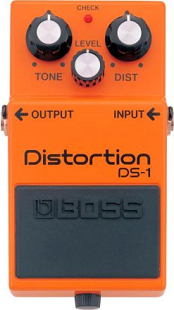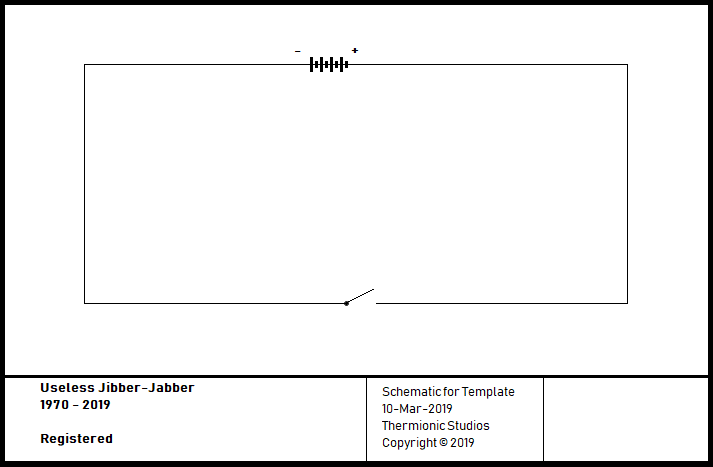DS-1
Boss DS-1 Distortion. Including the ProCo Rat, and the Electro Harmonix Big Muff Pi, this pedal has become renown for having earned the hearts of not only aspiring rock stars, but also for well-seasoned studio musicians and celebrity professionals.
The Boss DS-1 has gone through a couple of incarnations: the older and more highly-esteemed Made-in-Japan model, and the less-valued post-Japan model. Candidly, we don't really hear much of a difference, if any at all. After listening to a shoot-out between new and old models, many actually hear the newer DS-1 as "thicker" or "meatier" and like it better than the vintage model.
We have an MIJ-version DS-1 - not because we were on the look-out for a Made-in-Japan DS-1, but because we spied one at Goodwill one day. It was practically mint condition and the right price so we decided, "why not?"
- Thermionic Studios has one(1) Boss black-label (Made-in-Japan) DS-1 available for rental.
Controls

- Knob 1 - "Tone": Adjusts the Tone with fully clockwise allowing all the high-frequency tone information into the signal.
- Knob 2 - "Level": Adjusts the output level with fully clockwise full loudness.
- Knob 3 - "Dist": Adjusts the distortion level with fully clockwise being maximum distortion.
- Footswitch 1 - "On/Off": This footswitch toggles the pedal between engaged/active ("On"), and bypassed ("Off")
Bypass: Buffered
The DS-1, like all Boss pedals, has a buffered, but high-quality bypass.
General Information
First offered for sale in 1978, the DS-1 Distortion was a follow-up to the Red-Yellow-Green pedal "marketing release" of the Boss SP-1 Spectrum (red), the OD-1 Overdrive (yellow), and the PH-1 Phaser (green).
Originally, it was well received and today continues to be a consistent seller for Boss.
We have posted both the schematics and the Owner's Manuals for the Made-in-Japan version of the DS-1, and the afterwards version.
Post-Japan
Once Boss stopped making pedals in Japan and transitioned over to manufacturing in Taiwan, the architecture of the electronics changed. Most notably, a dual-opamp was used in place of the original single TA7136. Of course, other changes were made in resistors and capacitors in an attempt to make the pedal sound the same, but it doesn't.
We're fairly agnostic with respect to the sound of a modern DS-1 as compared to a vintage DS-1. Speaking from personal experience, I (Zander), had a friend with a DS-1. It was the early 1980s and I decided I wasn't going to go with that "sissy" Distortion, I was going to get an HM-2 Heavy Metal pedal! And I did... Now, while I loved the HM-2, I came to find later that it had a huge problem getting lost when you were playing in a band setting.
The DS-1 doesn't seem to have this problem.
Pedal Manual
Phase Inversion: Yes/No
| Schematic ID | Electronic Part | Action | Phase State |
|---|---|---|---|
| X | X | X | X |
Schematic
Artists
We are currently unaware of any artists actively using the pedal now, or who have in the past.
- Additional Sources
- https://www.diystompboxes.com/DIYFiles/up/Build_Your_Own_DS-1_Distortion.pdf
- https://www.youtube.com/watch?v=RhTxcfcT9fU - Listen for yourself to see if there's a big difference...
